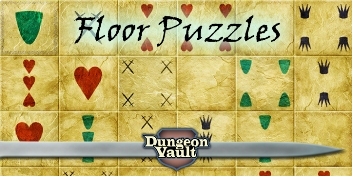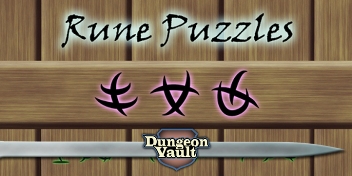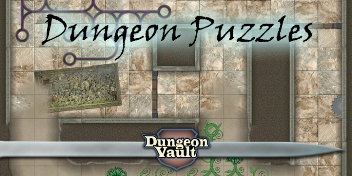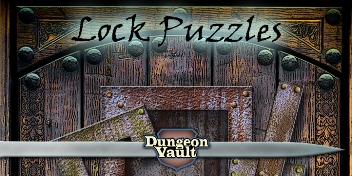In Dungeons and Dragons encountering room after room of monsters and the occasional trap in a dungeon can get stale for a group of players. As a DM, you have to keep players on their toes by introducing a variety of challenges. Using dungeon puzzles is a fantastic way to mix it up.
But not every puzzle works well in a dungeon. So what are the best D&D puzzles to put in your dungeon, that will fright and delight your players?
We’ve ranked the 7 best D&D puzzles to use in a dungeon.
7/7
Floor Puzzles for a D&D Dungeon
 Floor Puzzles do exactly what you would expect. You place this puzzle on the floor of a room in your dungeon. Following the rules of the puzzle, PCs must walk the correct pattern over the floor tiles to unlock a door, make a rope drop from the ceiling, and so on.
Floor Puzzles do exactly what you would expect. You place this puzzle on the floor of a room in your dungeon. Following the rules of the puzzle, PCs must walk the correct pattern over the floor tiles to unlock a door, make a rope drop from the ceiling, and so on.
You can use these as generic puzzles, but they also come with a lot of flavor involving four races: Orcs, elves, halflings, and dwarfs. So if that fits the lore of your dungeon it’s easy to incorporate.
Another highlight of this puzzle is that it comes with 5 completely optional card games. PCs can play a few quick hands and – without realizing it – learn the rules to the puzzle. So explaining how the puzzle works becomes a natural part of the game. We think that’s just brilliant!
We rank this puzzle 7 out of 7 for D&D dungeons because they go with any dungeon and can easily be placed in a room. The largest puzzles can be difficult but sometimes you need a good challenge.
6/7
Elemental Puzzles for a D&D Dungeon
 Elements are a classic aspect of dungeons in D&D. Who doesn’t remember the chills and thrills of the famous ‘Temple of Elemental Evil’? If you haven’t played it, we recommend it. The elemental theme really elevates this dungeon beyond the ordinary. And using elemental puzzles can do the same for your dungeon.
Elements are a classic aspect of dungeons in D&D. Who doesn’t remember the chills and thrills of the famous ‘Temple of Elemental Evil’? If you haven’t played it, we recommend it. The elemental theme really elevates this dungeon beyond the ordinary. And using elemental puzzles can do the same for your dungeon.
This puzzle can easily be placed on the floor of any room in your dungeon. Players must use the four elements to solve the puzzle which opens the door to the next dungeon room. How the next room is revealed is up to the DM. A wall can collapse, a secret door becomes outlined, or a portcullis raises. Just like you want to mix up types of challenges players face, you can also mix up ways the next dungeon room is revealed.
What makes this dungeon puzzle extra fun for your D&D game is that the solved puzzle on the floor can double as interesting terrain for a combat encounter. PCs have to dodge lava pits and avoid being swept away by whirlwinds. But they can also use these environmental hazards against their enemies! The puzzle even comes with tokens of followers of each element so you can quickly set up factions in your dungeon.
We rank this puzzle 6 out of 7 for D&D dungeons because it is very easy to implement with lots of flavor and versatility.
5/7
Game of Shields Puzzles for a D&D Dungeon
 The game of shields is a bit of an odd duckling in this list because it can both be used as a puzzle and as a complete system for running politics in your campaign. For dungeons, we’ll only use the puzzle part of this pack. Here’s how.
The game of shields is a bit of an odd duckling in this list because it can both be used as a puzzle and as a complete system for running politics in your campaign. For dungeons, we’ll only use the puzzle part of this pack. Here’s how.
This puzzle contains 81 heraldic shields that look great on any dungeon wall. Each shield represents a faction. following the rules outlined with this puzzle, PCs must find an alliance between three factions. If they simultaneously press on those three shields, a door opens, a guardian grants safe passage, and so on.
Of course, PCs could also pry off a shield to use for defense. And walking around the dungeon with a shield belonging to a specific faction might gain PCs extra enemies or allies. Having these shields as a puzzle adds an extra layer of history to your dungeon. And who knows, you might even wish to use the political system once the heroes emerge from the dungeon.
We rank this puzzle 5 out of 7 for D&D dungeons because it works very well as a dungeon dressing and adds history and story hooks to your dungeon.
4/7
Rune Puzzles for a D&D Dungeon
 Rune Puzzles are probably the most versatile puzzle we’ve ever seen and perfect for D&D dungeons. Each puzzle is a string of runes you can drop onto any object. So you can use these runes to lock a door. But you can also place them on the ground to create a wall of force that can only be turned off by solving the puzzle.
Rune Puzzles are probably the most versatile puzzle we’ve ever seen and perfect for D&D dungeons. Each puzzle is a string of runes you can drop onto any object. So you can use these runes to lock a door. But you can also place them on the ground to create a wall of force that can only be turned off by solving the puzzle.
Those are the obvious uses but you can get very creative with this puzzle. You can lock books in a library that hold a clue to a different puzzle, chests, magic items, or trap hordes of undead.
We rank this puzzle 4 out of 7 for D&D dungeons because of its great versatility and ease of use. These also work great for improvisation. Just show players the image of the puzzle and let them figure it out.
3/7
Runestone Puzzles for a D&D Dungeon
 One of the great things about this puzzle is that the runestones can be the size of a PC’s fist, as big as a 5 by 5-foot square, or any other size you wish. Runestone Puzzles can be placed on a floor with each stone filling a 5 by 5 ft square. Moving the massive stones becomes a part of the puzzle.
One of the great things about this puzzle is that the runestones can be the size of a PC’s fist, as big as a 5 by 5-foot square, or any other size you wish. Runestone Puzzles can be placed on a floor with each stone filling a 5 by 5 ft square. Moving the massive stones becomes a part of the puzzle.
You can also place fist-sized runestones into slots in a stone dungeon door. But our favorite is to place them on a pedestal in the middle of a dungeon room so PCs can gather around just like how they are viewing the puzzle on your table.
With this puzzle, PCs must first find all the stones to solve this puzzle, which you can distribute throughout the rooms they’ve already explored. Next, they must lay out the runestones in a pattern where matching symbols touch.
A highlight of this puzzle is that you can create endless puzzle setups very quickly. So really with this puzzle, you get the means to create infinite puzzles. And the puzzle comes with many story options to add to your D&D dungeon. Because PCs need a specific set of stones to solve the puzzle, you can place them in other rooms. This way, you can control how players will explore the dungeon. If you want to learn more about how to use puzzles in this way check out this article where the designer of this puzzle goes into much more detail.
We rank this puzzle 3 out of 7 for D&D dungeons because of its ability to create endless puzzles on the fly gives this puzzle great replay value. And the artwork is just beautiful as well.
2/7
Dungeon Puzzles for a D&D Dungeon
 When a puzzle is called ‘Dungeon Puzzles‘ you might suspect it to be just perfect to place in your D&D dungeon. But that isn’t how this puzzle works. Instead, with Dungeon Puzzles the dungeon IS the puzzle!
When a puzzle is called ‘Dungeon Puzzles‘ you might suspect it to be just perfect to place in your D&D dungeon. But that isn’t how this puzzle works. Instead, with Dungeon Puzzles the dungeon IS the puzzle!
This amazing puzzle changes your entire dungeon into one giant puzzle. Players solve this puzzle by laying out 4 by 4-inch dungeon tiles. And when they are done you can immediately use the solved puzzle tiles as the dungeon map they place their miniatures on. So it’s a puzzle and a dungeon map all rolled into one.
We rank this puzzle 2 out of 7 for D&D dungeons because it doesn’t get more dungeon themed than this and our players voted this their favorite puzzle to solve.
The puzzle also comes with extra tiles for puzzle setups that you can place into a dungeon room. But we think the first use is much cooler. Technically, this isn’t a puzzle you put in a dungeon and that’s the only reason it’s not our first place pick.
1/7
Lock Puzzles for a D&D Dungeon
 Lock Puzzles is our number one pick for a D&D dungeon puzzle. With just nine very basic puzzles you can create endless setups that range from super easy to nearly impossible to solve. The more basic puzzles you add, the higher the difficulty.
Lock Puzzles is our number one pick for a D&D dungeon puzzle. With just nine very basic puzzles you can create endless setups that range from super easy to nearly impossible to solve. The more basic puzzles you add, the higher the difficulty.
The concept of this puzzle is simple. Fill out all the puzzle slots. Each slot holds three puzzle pieces and can be filled out in various ways. But there’s only one way to fill out all the slots.
You can place these slots on a door or any object really. But a very interesting use is to place them in different rooms of your dungeon. This way, you split up the party and every PC has to fill out their own slot. Players must cooperate very closely to solve the puzzle with this setup.
We rank this puzzle 1 out of 7 for D&D dungeons for several reasons:
- First of all, you can create over 500 different setups with the basic set of puzzles giving it massive replay value. But really, if you add more pieces the options become infinite.
- The second reason is that you can drop these puzzles onto any object you wish to lock. It doesn’t have to be a door.
- The third reason is that you can hide the puzzle pieces in other rooms, just like you can with the runestone puzzles. So PCs have to collect them, find them as treasure, or defeat monsters who guard puzzle pieces.
- The fourth reason is that this puzzle requires no explanation. Players will naturally figure out they have to fill the slots with puzzle pieces. But because there are multiple slots, doing so is more difficult than they expect.
- The fifth reason is that you can adjust the difficulty of this puzzle on the fly very easily.
And our final reason is that this puzzle has just the right kind of dark and gritty look we expect to see in a D&D dungeon. But that’s just our personal preference.
Dark Ulf is the founder and editor of DNDpuzzles.com. When not writing for DNDpuzzles he travels the multiverse and destroys demons with a crossbow in one hand and a crossword in the other.
We hope this site inspires you to put more puzzles into your D&D games.


